Russia’s invasion of Ukraine destroyed Oksana Kuzminskaya’s house, drove her family from their hometown of Snihurivka, and then turned even her beloved Inhulets river into a threat.
Through the empty window frames of her ruined home, which was hit by the blast wave of a Russian airstrike 15 months ago, she can see the Inhulets gleaming beyond the wrecked family car, the garden where she reared ducks and chickens and the wildflowers now running riot on the land she used to tend.
But now the Inhulets is a kilometre wide – where before barely 50 metres separated its banks – and only the tops of traffic signs and the crowns of trees show where roads and bridges were swallowed up by swirling floodwaters.
“First occupation and now this – it’s another nightmare for the town,” Kuzminskaya says of Snihurivka, where the water level rose by six metres in the hours after the Russian-controlled Kakhovka dam on the Dnipro river was destroyed last week, sending some 18 billion cubic metres of water surging towards the Black Sea and up the Inhulets, a tributary of the Dnipro.
READ MORE
The flood is feared to have killed dozens of people and has displaced thousands in areas liberated by Ukraine last November and in territory on the eastern bank of the Dnipro that is still held by Russia, which denies responsibility for the disaster despite very strong indications that its troops blew up the dam or caused its collapse through incompetence.
The worst damage was across Kherson region, but in Snihurivka and surrounding villages in the neighbouring Mykolaiv province, the flood damaged more than 360 houses, forced more than 650 people from their homes, cut power supplies, inundated wells for drinking water and a major pumping station, and drowned fields, gardens and allotments where locals grow fruit and vegetables to help see them through the winter.
It puts huge strain on a district where more than 1,500 buildings have been damaged in fighting and on the 12,000 people now living here – some 4,000 more than were here during occupation, but still only about half the pre-war population.
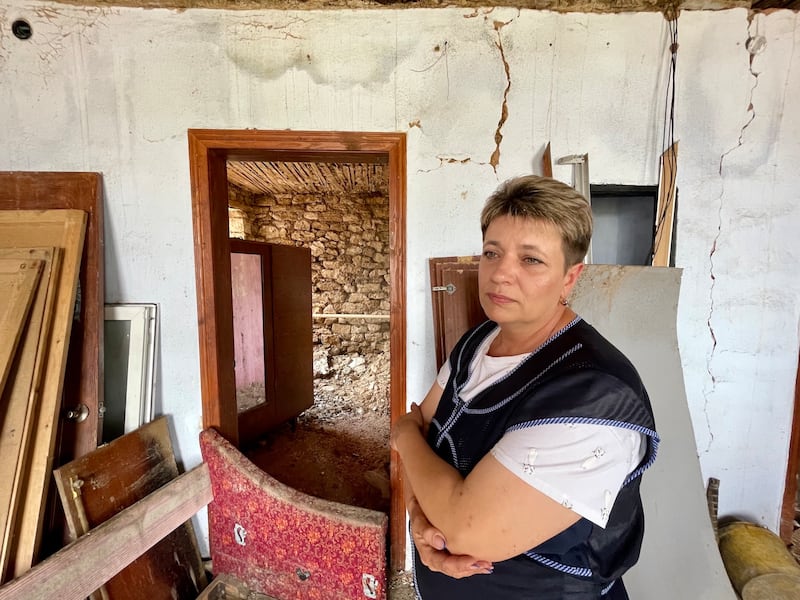
Kuzminskaya now has no gas or electricity in the house she rents with her husband and two children and says she still feels unsafe in Snihurivka, which is now about 50km from the front line as Ukraine’s forces mount their counteroffensive to retake more territory.
“There was an air raid siren this morning and my daughter and I dashed straight for the basement,” she says, as she steps from the shade of the grocery shop where she works into the bright sunshine of the street and sets off towards her old house. “I still get the shivers when I talk about what happened last year.”
Now there’s no water because of the flooding. I don’t know what the Russians are thinking, just destroying everything. It’s madness
— Iryna Kravets, Snihurivka
Kuzminskaya (45) and her family were at home when a Russian bomb fell on their street, tearing off the roof, shattering the windows and ripping through the walls of her house.
“There was a huge explosion and plaster fell on us and I thought the ceiling was going to come down. Thankfully it held and we weren’t hurt, though my husband was on crutches at the time after an operation,” she recalls.
“We spent a month living in a basement with about 350 others, including elderly people and families with little children. There was bombing every single night. It was horrendous.”
Like Kuzminskaya, Iryna Kravets finally fled from Snihurivka to a safer part of Ukraine, and returned home when the town was liberated.
“It was a tragic sight when I came back. There was so much damage to the town and my own house had been burned down,” says Kravets (24), holding 10-month-old daughter Eva in her arms.
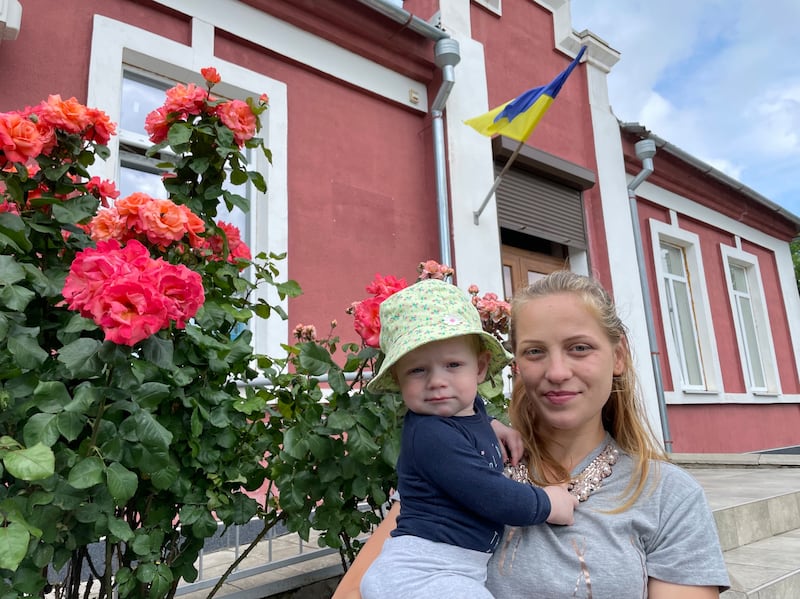
“We were given a house, and it’s okay. But now there’s no water because of the flooding. I don’t know what the Russians are thinking, just destroying everything. It’s madness,” she adds. “Look at the size of the river now, how much land it has covered up. It was so narrow before – I swam across it when I was a teenager.”
On the river, members of Ukraine’s state emergency service guide boats past electricity pylons and road signs, under power lines and over submerged bridges to deliver food and other essentials to flood-bound villages. At the height of the flood, they carried vulnerable people to safety on higher ground, and are now taking some evacuees home.
In the village of Novovasylivka, local men and boys wait by flooded riverside buildings to transfer deliveries from the boat into a waiting trailer, which then bounces away behind a blue Soviet-era tractor to a school that has been turned into an aid distribution centre.
Inside, sporting a bright yellow T-shirt and leopard-print headscarf, village head Vita Bardizh takes a stream of calls from residents and officials in neighbouring communities, while organising volunteers as they arrange piles of clothes, hygiene products, food and other supplies donated by Ukrainians and aid organisations.
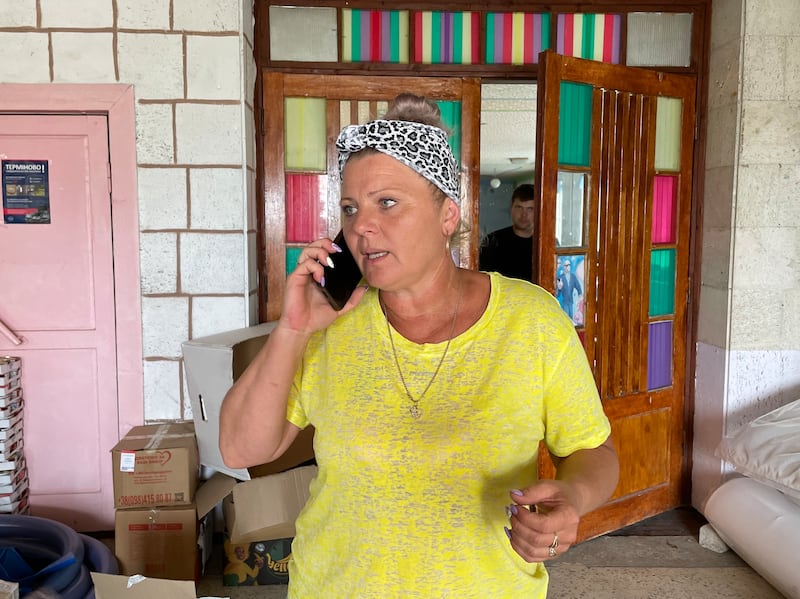
“We had no idea what was coming on the morning of the flood. We just got up as usual and checked our phones and the news and Facebook,” she recalls.
“Some said the floodwater won’t reach here and not to worry, but by about mid-morning the water was starting to rise and a few people began to panic. In the end it rose by about six metres. We knew which areas were in danger and offered to help people leave, but some didn’t want to go. In the end, 64 buildings in our village were flooded, some partially and some right up to the roof.”
She does not know whether the district’s recently rebuilt bridges will emerge intact when the water recedes, or what will be left on the land, amid warnings that the torrent swept up chemicals and waste from industry, households and farmland, mines and other explosives from current and former front-line areas, and countless animals that could not escape the danger zone.
“People’s kitchen gardens have been flooded and a lot of pasture for animal grazing, too. It will make life hard here if that land is ruined,” says Bardizh, who was born in Novovasylivka and stayed during the occupation.
I never took food packages or anything else from the Russians, but some did. And some of them are here now, taking help from people who are helping Ukraine
— Sveta Mironenko, Yevhenivka
“The Russians mined the bridges and mostly stuck there. Sometimes they came into the village on patrol and searched our houses. They took some people to Snihurivka and beat them. My cousin was detained and beaten for two days because his brothers serve in our armed forces, and the Russians wanted to know the locations of their positions.”
Bardizh was most worried for her son, who at 17 was just a year short of being eligible for the Ukrainian army.
“The Russians kept asking how old he was. I told him to go out as little as possible, and for the first couple of months [of occupation] we barely left the house,” she recalls.
“The Russians tried to take my car but I told them there was no way I would let them, because I have two children and elderly parents to look after. And they left me alone. But they stole lots of people’s cars and drove away in them when they retreated from here.”
As with many people in Snihurivka and surrounding villages, the thrill and relief of liberation are still palpable, as Bardizh recalls the foggy November day when Ukrainian soldiers emerged from the gloom and told them the Russians had gone: “Honestly, when we saw they were our lads, we kissed their hands and feet,” she says.
In the nearby village of Yevhenivka, Sveta Mironenko shares similar memories.
“Liberation was an indescribable feeling. It immediately felt easier to breathe, the air itself seemed different,” says Mironenko, whose husband signed up to rejoin the army on the morning of February 24th last year, just hours after Russia’s full-scale invasion began.
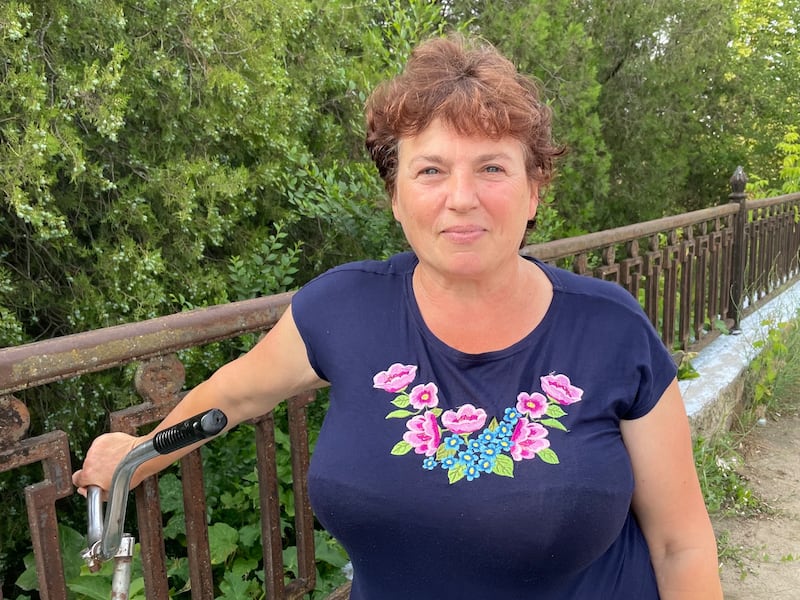
However, she claims that – as in other occupied areas – Ukraine’s return was not welcomed as warmly by all her neighbours, nor were the Russians universally despised here.
“Some people here seemed to get on fine with the Russians. And some local people stole things from the houses of those who had left the village,” Mironenko recalls.
[ Ukraine’s destroyed dam: ‘The legacy will last dozens of years’Opens in new window ]
“I never took food packages or anything else from the Russians, but some did. And some of them are here now, taking help from people who are helping Ukraine,” she says, as workers from Odesa-based charity New Dawn hand out food parcels to dozens of villagers.
Oleh Kulakevych, executive director of New Dawn, says many major aid groups and volunteers headed immediately for the city of Kherson on the Dnipro river when the flood began, so his team ventured up the Inhulets and found local authorities in need of help.

“We went to Snihurivka and surrounding villages delivering water, food, water pumps and filters, life jackets and inflatable boats,” says Kulakevych, who as a trained electrician also managed to isolate a major power line while working from a boat on the rising floodwater. The group is also co-ordinating the drilling of new wells in the area after existing water sources were flooded.
I don’t want some prefabricated house. I want to rebuild here, in the place I had my family. I want to have my garden back again
— Oksana Kuzminskaya, Snihurivka
Beneath a portrait of Taras Shevchenko, Ukraine’s national poet, Ivan Kukhta sits at his desk and lists his main worries as the head of Snihurivka’s military administration.
“Practically all of Snihurivka is without running water, because five of our six pumping wells are flooded. We’ve opened water distribution points, but that just covers the minimum of people’s needs,” he says.
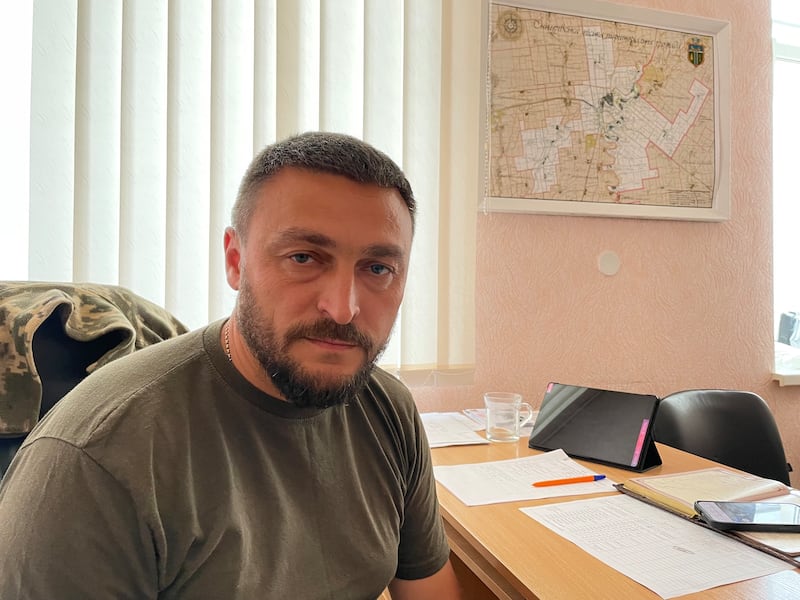
“There are 13 communities in our district and most have no power or water. Then we have to think about the destruction of homes and gardens, roads and bridges – which we rebuilt after they were blown up during occupation. These are big problems,” he adds.
Kuzminskaya gladly returned to her job in a grocery store when Snihurivka was liberated, but she rejected an offer of housing from the authorities.
[ The Irish Times view on the explosions at the Kakhovka dam: an act of destructionOpens in new window ]
“I don’t want some prefabricated house. I want to rebuild here, in the place I had my family. I want to have my garden back again, and my ducks and chickens and my view of the river,” she says.
Kuzminskaya, whose fingernails are painted in the blue and yellow colours of Ukraine, is standing in her shattered living room, where swallows have made a nest high in one corner. One of them swoops in through an empty window frame, knifes through the shadows and curves back out into the sunshine.
“I want life to be calm and peaceful here,” she said.
“And for Ukraine to win the war.”



















